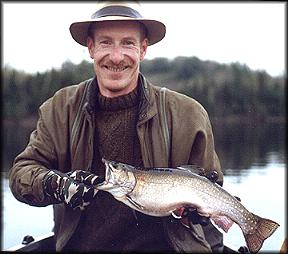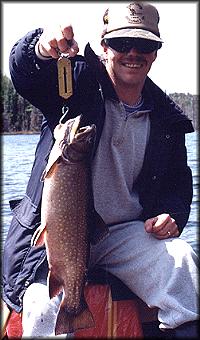BROOK TROUT, OUT in the STICKS
By Kevin Fancy
During mid-morning the crystal clear sunlight filters down through a
glistening canopy of multi-coloured leaves. A soft breeze stirs the
branches, which in turn casts an ever-changing pattern of light and dark
that dance wildly on the forest floor. The crisp cool air smells clean,
almost new, tasting pure as if no other creature had ever breathed it
before. The sky is as bright and as blue as any cornflower, broken only
by billowing towers of snow white clouds. When the Canadian north looks
and feels like this, it is a sure sign the long hot days of summer are
almost here and the brisk inconsistent days of spring are upon us.
It is on such beautiful days as these that the avid angler scratches his
or her first itch to fish in fine weather. It is time to pack up the
gear and head out for the first kick at the cat. One quarry (other than
the cat) that is ready to bite in this "early season" is the brook
trout. Speckled trout to some. The brookie as I fondly call them can
be a tad finicky when waters are still cold. Not so much because the
cooler water slows down their metabolism, as some believe, but more so
because spring is slow to arrive in the cold Canadian depths and bug
hatches and other food sources are slow in coming. Catching a spring
Brookie takes a little planning and you should have at least a little
advanced knowledge of the waters you intend on fishing. At this time of
year location is a crucial factor.

If you think structure is important in the spring and summer, I am here
to tell you that it is the only thing that counts, period! Forget
thermoclines, they are almost non-existent in the mid to late spring.
Drop off areas and mid lake humps? As far as the brookie is concerned
they mean nothing unless accompanied by feeder streams. Weed lines?
The still growing vegetation provides little cover and less oxygen. So
what is left? One of the most prime areas to fish for spring brookies
is in the pools of a fast to moderately flowing streams. The fish found
here are however waiting only for opportunity to knock at the door.
Often when these fish strike it is out of anger or reflex, always they
are interested in food.
There are also many lakes and ponds stocked by the government that offer
tremendous fishing in the spring. Since most of these streamless waters
are stocked and the fish will never successfully spawn, you can feel
good about bringing a few of these multi-coloured marvels home for the
fry pan any time of year. So leave the running water behind and head
instead to a still water where, in my opinion, you may find one of the
best places to fish spring brookies. Where should you start when faced
with a huge expanse of leaf littered lake or pond? If you promise to
keep it to yourself I will let you in on a secret. Are you ready for
this? Shh, are we alone? OK, remember you promised. The best place to
look for fall brookies in a lake or large slow moving river is in and
among shallow shoreline structure.
RIP RAP, CRIP CRAP and TREE SAP
So, having discounted traditional drop off areas (except near stream
mouths) and weed beds, you may ask yourself what's left? There are in
fact two key areas of structure left to fish that we have yet to
mention. One is the dead or windfall trees that lie at the waters edge,
while the other is beaver or muskrat lodges.
The fallen tree is an ideal place to find brookies at any time of year.
On some lakes however there is so much fallen timber that it is hard to
pick the ones that offer the best fishing. In places where the
deadfalls are abundant, look for one that is adjacent to deep water and
is more or less alone. In the spring don't ignore the back bay falls
and sticks and keep one eye open for lone falls on points. These spots
offer the best chance for catching fish.
As far as animal made structure goes, I say, avoid muskrat lodges. The
Muskrat's lodge is easy to distinguish from the beaver's because they
occur in shallower water and look like an old fashioned hay stack of
grass with a few sticks where as a beaver lodge contains very little
grass and appears to be mostly sticks and mud. Why should you stay away
from muskrat houses? Muskrats predate on brookies. Beaver on the other
hand are vegetarian and don't mind the company of fish at their front
(under water) porch. Brook trout and other fish are not terribly afraid
of beaver and quite enjoy the security their dams and lodges offer. Now
you might wonder what kind of structure a beaver lodge has that would
appeal to a fish. The truth is, underwater where the angler doesn't
see, is a forest of branches shoved into the bottom by the busy beaver
each fall. These pieces of green wood will be the rodent's winter food
source. This stand of submersed deadwood may extend for dozens of yards
around the lodge offering an ideal hiding spot for a wary fish.
In pools below dams is also a great place to find spring brookies.
Besides the branches that have broken away from the main structure and
remain submerged, there is running water which is oxygenated as it falls
and all sorts of insect larvae, leaches and minnows that take advantage
of the current breaks a beaver dam creates as the water begins to warm.
TEASING UP A LUNKER

There are many ways to work a dam, lodge or deadfall and none are
exclusive to spring angling. Live bait such as worms, leaches or small
(underline small) minnows are you best bets for spring brookies. If the
water is cold still, avoid leaches. Even if they are available at your
local tackle shop. They literally won't work in cold water. Leaches
roll themselves up in a ball when it's cold and offer little
attraction. Worms are good, but stay away from the big fat dew variety
and look instead for smaller manure or red wiggles as they are called.
Thanks to recycling, wigglers are now available year-round from shops
that sell worm composters. When you see how well they work you may want
to raise them yourself at home, but that is a whole other story. Keep
your minnows small. Any time of year brookies prefer small minnows over
big. I don't know why, I have just come to accept it as an unproven
fact.
Your options don't stop with live bait either. Trolling with streamer
flies on a sinking line works the best of all if the fish aren't buried
in structure. Small plugs and spinners cast into the shallows work well
too. Try a Creek Creature or a Tad Polly or any one of the blossoming
varieties of micro baits now available on the market. Mepps also makes
a number of spinners in the O size that when tipped with a worm is
deadly. Cast them towards the deadfall or dam and work them slowly back
to you. The same goes for any fly you might choose. The main problem I
have found with using any non-fly baits when fishing dams and lodges is
how much you find yourself hung up. That is why I personally avoid the
use (and loss) of costly plugs or spinners. Despite what some folks
think we writers do pay for ninety percent of our gear. This is why I
have perfected the art of fly-fishing. My favorite bait choice.
WORM DUNKING 101
Aw, stop turning up your nose. You know they work and it's more
embarrassing to come home with an empty creel than admitting to having
resorted to worm fishing.
The best way to fish a worm for spring brookies is on a small hook, or
better, two small hooks. One hook in the nose (so to speak) of the worm
and the other about two-thirds the way down. Hooking a worm this way
accomplishes two things. First, if a hungry brookie tries to inhale the
entire bait on its first attack you have the advantage of possibly
setting two hooks. Secondly, if the fish are in a pecking mood, which
is seventy-five percent of the time, the first few attacks will only
whittle away at the tail. When the fish reaches the lower hook it will
feel less spooked and you may get a good hook-set. If you miss on the
lower hook at least you can still leave your bait in the water and hope
you get a second shot with the top hook.
Once your line is rigged with a tandem hook and your wiggler is in place
you need to use sinking fly line or a sinking tip to get it down. Some
folks prefer to allow the worm to sink at its own speed so the
presentation is a bit more natural. I agree with this approach. If you
can roll cast the worm combo without throwing the bait you have got it
made. Cast right up to the edge of the structure and slowly strip the
line back to the dam or boat, stopping the retrieve several times to
allow the bait to hang. If you are fishing from the dam do the same
thing in reverse. Cast out to deep water and retrieve to the
structure. If after a few casts you have not gotten a slow down or
speed up your retrieve and try again. At this time of year the fish
could be suspended at any level. Fan cast the entire area you are
fishing at each level until you hit the right combination of speed and
distance. From a boat or from on top of a lodge; give this dam approach
a try.
~ Kevin Fancy
Our Man In Canada Archives
|

 May 24th, 1999
May 24th, 1999


